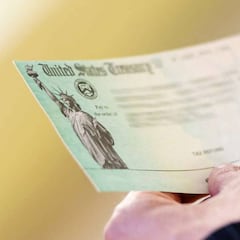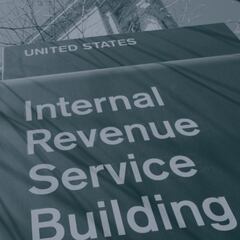How many stimulus checks have been issued and what are the differences between them?
Both President Biden and Trump passed covid-19 relief bills which provide Economic Impact Payments to eligible Americans. Here's how the three stimulus checks compare.

The coronavirus was first declared a global pandemic by the World Health Organization on March 11 2020. Nearly 13 months later the United States is the country worst hit by covid-19, with the total number of reported cases at 30,851,290 and 556,578 deaths related to the virus, according to today’s figures.
The pandemic has caused sweeping job losses with unemployment hitting a high of 14.8% during April 2020 – the worst month of the crisis. Unemployment figures have since recovered and currently stand at 6.0% as of April 2021.
However the monumental financial consequences that the pandemic has had on both individuals and businesses has prompted lawmakers to draw up a series of covid-19 relief bills to bring economic aid.
- IRS outlines timetable for stimulus check payments
- How much would a fourth stimulus check be?
- IRS plus-up payment: what is it, how much is it and who gets it?
- Fourth stimulus check: is a new relief bill viable?
Trump signs first covid-19 relief bill in March 2020
The CARES Act was signed into law by former President Donald Trump on Friday 27 March 2020. The CARES Act provided a first round of stimulus payments valued at $1,200 for each individual who satisfied a set of conditions, with $500 for each eligible dependent under 16 years of age, with a maximum of three dependents per household.
The payments were made to everyone earning under the income threshold, which was set at an Adjusted Gross Income of $75,000 ($150,000 for married couples filing jointly) with the stimulus check value reducing by $5 for every $100 in income up to a maximum of $99,000 ($198,000 for married couples filing jointly).
✓ Passed the Senate
— Senate Republicans (@SenateGOP) March 27, 2020
✓ Passed the House
Next stop → @realdonaldtrump's desk
Help is on the way. pic.twitter.com/oCGRMwh2Ia
The very first stimulus checks were paid into people's bank accounts over the weekend of the 11 and 12 April. The payments came as direct deposits into individuals’ bank accounts; paper checks sent through the post; and approximately 4 million payments were issued on prepaid Economic Impact Payment (EIP) Cards which were sent out in late May last year.
Congressional talks for a second stimulus bill
By July, discussions had already began for a second round of stimulus aid; the CARES 2 package was reviewed by the administration and an agreement in principle was reached on the basic points outlined in the package but it never made it to the Senate or passed.
Nor was the HEROES Act, a $3 trillion economic stimulus bill which was passed by the House by a vote of 208–199 on 15 May 2020 with further negotiations and modifications dragged out over the next few month before dying a death before it reached a Senate vote.
Emergency covid-19 relief package signed in December 2020
The second round of stimulus aid, a $900 billion package which was part of the Coronavirus Response and Relief Supplemental Appropriations Act of 2021 was signed off by Trump on Sunday 27 December 2020. It provided a one-off payment of up to $600, with households also able to claim an additional $600 for child dependents aged 16 or under.
Those who earned under $75,000 in the 2019 tax year received the full stimulus check, while a steadily smaller figure was given to those on a higher annual income, up to a maximum phase-out limit of $87,000. The first payments, through direct deposit and paper checks with some later payments made by EIP 2 Cards, were issued between 29 December 2020 and 15 January 2021.
Those who didn’t receive a stimulus payment either through the CARES Act or the December covid-19 relief bill can still claim it retroactively when filing their federal tax returns for 2020 through the Recovery Rebate Credit.
This year, the tax deadline for individuals to file and pay most federal income taxes has been extended to Monday 17 May 2021. Claimants will also be able to claim any additional money owed by the IRS from the first round of payments sent out earlier in 2020 as a credit.
Biden signs the American Rescue Plan into law in March 2021
The third, most recent round of covid-19 stimulus came as part of the $1.9tn American Rescue Plan Act which was passed by the House of Representatives on 26 February by a vote of 219–212 then just made it through the Senate with a 51-50 vote. It was approved on 10 March and passed over for recently-elected President Joe Biden to sign it off on 11 March.
Since we passed the American Rescue Plan, we’re starting to see new signs of hope in our economy. pic.twitter.com/EZys2d0aG7
— President Biden (@POTUS) March 26, 2021
It promised stimulus checks of up to $1,400 for each eligible American. There were some changes - eligibility requirements tightened to exclude individuals earning over $80,000 or couples with a combined income of more than $160,000. Another eligibility change saw adult dependents able to get a stimulus check for the first time, meaning that millions of college students, elderly relatives and disabled Americans will be getting a payment.
The first stimulus payments were issued by direct deposit and hit individuals’ bank accounts on Saturday 12 March. By Wednesday 7 April the IRS confirmed that 156 million payments had been issued, totalling around $372 billion in federal support.
What are the chances of a fourth stimulus check?
Related stories
Plans for a fourth stimulus check are gaining support from Congress. A number of Democrats continue to push for a fourth check which would include recurring payments until the pandemic has waned. Newsweek report that 64 lawmakers are calling for a fourth stimulus check with recurring checks to follow.
Earlier this month, 11 Senators, including Bernie Sanders and Elizabeth Warren, called for Joe Biden to extend unemployment compensation indefinitely on top of another round of checks. There have also been suggestions that Biden is considering extending the new Child Tax Credit into a permanent programme.

